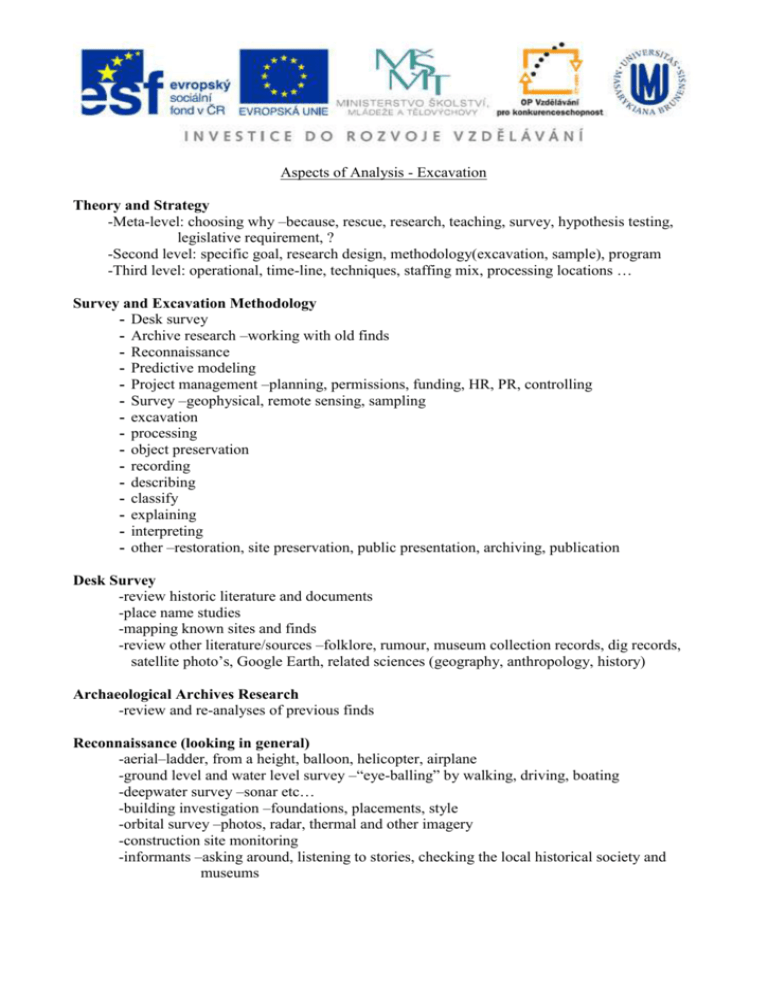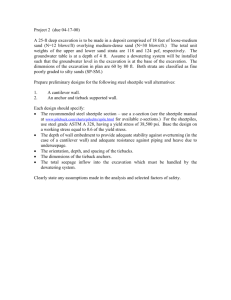Trends in Archaeology
advertisement

Aspects of Analysis - Excavation Theory and Strategy -Meta-level: choosing why –because, rescue, research, teaching, survey, hypothesis testing, legislative requirement, ? -Second level: specific goal, research design, methodology(excavation, sample), program -Third level: operational, time-line, techniques, staffing mix, processing locations … Survey and Excavation Methodology - Desk survey - Archive research –working with old finds - Reconnaissance - Predictive modeling - Project management –planning, permissions, funding, HR, PR, controlling - Survey –geophysical, remote sensing, sampling - excavation - processing - object preservation - recording - describing - classify - explaining - interpreting - other –restoration, site preservation, public presentation, archiving, publication Desk Survey -review historic literature and documents -place name studies -mapping known sites and finds -review other literature/sources –folklore, rumour, museum collection records, dig records, satellite photo’s, Google Earth, related sciences (geography, anthropology, history) Archaeological Archives Research -review and re-analyses of previous finds Reconnaissance (looking in general) -aerial–ladder, from a height, balloon, helicopter, airplane -ground level and water level survey –“eye-balling” by walking, driving, boating -deepwater survey –sonar etc… -building investigation –foundations, placements, style -orbital survey –photos, radar, thermal and other imagery -construction site monitoring -informants –asking around, listening to stories, checking the local historical society and museums Predictive Modelling - based on above, local data and previous local archaeology, models can be developed to allow prediction with reasonable certain the potential or actuality of finds–“archaeological sensitivity” can be determined –used extensively in government land management planning in North America Project Management - project planning - obtaining funding - permissions - determining staffing requirements - public relations - site requirements –logistics, accommodations, travel, etc.. - equipment requirements - controlling –setting and staying in budget - ownership - storage - closure Survey (looking up close) -mapping –distributions, densities, locations, distances, relations to landscape -remote sensing -aerial –ladder, from a height, balloon, helicopter, airplane, remote drones -tech: photo, thermal, infrared, ultraviolet, seasonal, over time, radar -diagnostics: linear or ovoid features, crop marks, vegetation height, shadows, plowing, earthworks, differing ground cover, -ground level and water level survey -physical: rod/borer(hollow/solid), scraping (surface features) -acoustic: bosing or bowsing, sonar (striking the earth, projecting sound waves and echo measurement) -electromagnetic: -magnetometer (measure distortions in magnetic field made by objects) -radar (radiowave echo measurement) -electrical resistance measurement -gravity: microgravimetry (measuring gravity variation) -thermal: measure minute variations in temperature -chemical: phosphorous testing (diagnostic of ancient settlement site) -deepwater survey –sonar etc… -orbital survey –space craft, satellite –tech: photos (Google Earth), radar, thermal, reflective light intensity (various wavelengths) -diagnostic: visible objects, colour variations, thermal variation -each utilizes various techniques, some overlap: -sampling -non-probabilistic: utterly random and subjective –works well with well-informed researchers with experience -probabilistic: statistical techniques employed -simple random, stratified random (rand om by some sub-areas), systematic (every second square or whatever), stratified unaligned systematic (every second square of every sub-area) -data processing –use a computer and map please, correlate sensing with realworld maps (of any sort) Excavation -field work, dig, site work -sampling strategy -strategy –individual feature –“single context mapping” –vertical -emphasis on stratigraphy –“step trenching” “trenching” -horizontal -grid square –“open-area excavation” -combined -squares with sides (“baulks”) - Wheeler box-grid -sectioning –the division of a site into parts for digging, the sectioning of part of a square for close analysis of a feature Recovery -remove in situ -sieve(screen), float -remove whole earth context for later analysis –soil analysis etc.. -record location (plot) and provenance, photograph, remove, tag and bag Processing -off-site, field lab, specialist support and materials, first step preservation/conservation -cleaning, preparation, ID#, classification (sometimes), tagging, bagging, removal Object preservation Recording Describing Classify Explaining Interpreting Other –restoration, site preservation, public presentation, archiving, publication






